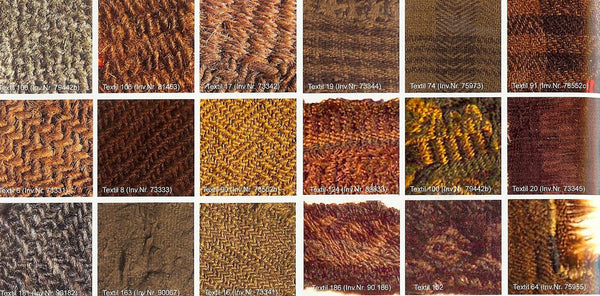About Herringbone
Herringbone Weave: Earliest Evidence
By Paul Shelton
Overview
Herringbone is a fairly ubiquitous pattern, seen today from a variety of wool suiting fabric to architectural elements such as tiling. It has been in use from antiquity through the Middle Ages through today. The exact provenance of the herringbone pattern is difficult to trace. The pattern itself can be traced back anywhere from ancient Roman roadways and buildings, to ancient Egyptian high status jewelry, to ancient indigenous North American basketry.1 However, the earliest herringbone fabrics are disputed. One unusual example demonstrates the use of woven horsehair cloth found among a cache of objects in a peat bog in Armoy, country Antrim in Northern Ireland dating between 750 and 600 BCE.2 Herringbone textile fragments from an ancient salt mining village in the Hallstatt region of Austria are comparable in age, dating between 800 and 400 BCE.3
Hallstatt: A Closer Look
Since 1849, approximately 240 textile fragments from the Bronze Age and Hallstatt period of the early Iron Age have been uncovered in the prehistoric salt mine, most of which (approximately 160) date to the Hallstatt period.3 The majority of the textile fragments consist of wool fibers – only two consist of linen.2 The Hallstatt Age textiles exhibit far more variation in weave structure than their Bronze Age counterparts. In the Bronze Age samples, there is only evidence for tabby and simple diagonal twill. However, the Hallstatt Period shows a vast array of weave structures known from Iron Age Europe including tabby, basket weave, diagonal twill, herringbone, zigzag and lozenge (diamond) twill, half basket weave, rep ribbons, and tablet weave.3 The textile fragments owe their remarkably well preserved state to the unique conditions in which they were discovered. Salt impregnation enabled organic material to survive for over 3,000 years.3
The Hallstatt period textiles are considered ‘Celtic’ in origin, a term derived from the Greek word Keltoi used describe a broad group of European inhabitants from the Middle Danube region to the British Isles.2 However, the term itself is misleading. Although the terms Keltoi/Celtae and Gali/Galatae were used interchangeably by Greek and Roman writers which later instilled romantic notions of European heritage during the Victorian period, there was no unified ‘Celtic’ tribe by any historical sense.2 Instead, these tribes might have shared similar linguistic roots, religious beliefs, stylistic elements in art, and perceived ‘otherness’ by Greco-Roman understanding.2 The significance of these particular textiles to these cultures is unclear.
A variety of colors were achieved for these fabrics which included natural whites and browns from both linen and wool in addition to coppers, reds, blues, olive greens, yellows, and blacks.2 Several plant-based dyestuffs such as chamomile, weld, madder, woad, and oak tannins were employed to achieve the vibrant colors.2 The Hallstatt period also saw the importation of insect-based dyestuffs such as the kermes from Polish and/or Armenian cochineal used for bright red dyes.2
In general, the Hallstatt Age yarns are of very fine quality, most being less than 0.6 millimeters in thickness.3 The Bronze Age fabrics, which are composed of coarse quality yarns of 1–1.5 mm in thickness, were more widespread during this period.3 Most Hallstatt period textiles are of fine to extra fine quality with more than 10–15 threads per centimeter in density.3 The Bronze Age samples are of poorer quality, medium to coarse with a density of four to five threads per centimeter.3 Despite the sumptuous nature of the fabrics, they were found threadbare in context of their salt mine surroundings. This suggests that the fragments belonged to the garments of commoners rather than aristocratic people.2
 A variety of woolen textiles from Hallstatt (10th - 5th centuries BCE). Source: ©K. Grömer, NHM Vienna.
A variety of woolen textiles from Hallstatt (10th - 5th centuries BCE). Source: ©K. Grömer, NHM Vienna.
Conclusion
Since the Hallstatt textiles were only discovered in fragments, the primary functionality of the fabrics is lost. However, the weave and thread count informs about the type of loom, weaving technique, signs of wear and tear, garment construction, etc. Although prominent, herringbone twill was less common among the other Hallstatt patterns. Given the intricacy and scarcity of herringbone, it could very well have been invaluable to the Iron Age Hallstatt cultures.
Sources
-
Brahms Mount Blog. Is it a Herringbone? Is it a Chevron? It’s far more than a Zig-Zag pattern!
http://www.brahmsmount.com/blog/herringbone-vs-chevron-whats-the-difference/
-
Archeologiehuiszuidholland. ‘Celtic’ Clothing (with Greek and Roman Influence) from the Iron Age-a Realistic View Based on What We Know. 1997.
-
Hofmann-de Keijzer, Regina, et. al. Ancient textiles – recent knowledge: a multidisciplinary research project on textile fragments from the prehistoric salt mine of
Hallstatt. 14th Triennial Meeting The Hague Preprints Vol. II. 2005.